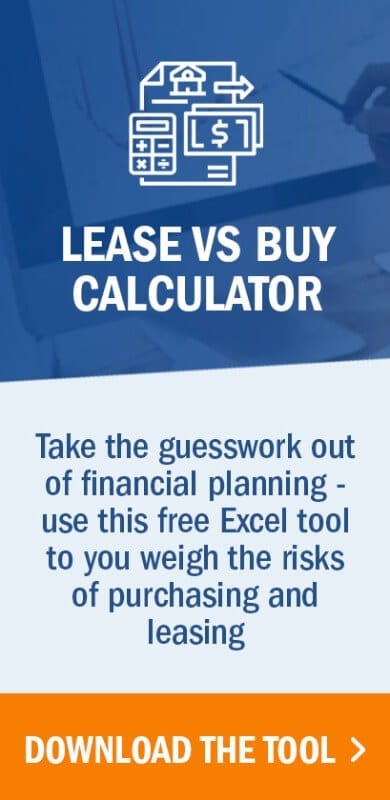Determining whether to lease or buy an asset is a common, and complicated, business decision. It impacts cash flow, financial reporting, taxes, and how long you’ll have rights to the asset in question. Most businesses have their own tried-and-true formula for lease vs. buy decisions. But two recent regulatory updates – ASC 842 (the new lease accounting guidance) and recent revisions to the US tax code – give cause to rethink those methods.
Understanding IRS Section 179
Section 179 was created to encourage businesses to make capital investments. Under this section of the tax code, you can deduct the full purchase price of an asset from your gross income in the year that it’s placed in service, instead of deducting it over a period of time according to a set depreciation schedule. For a five-year lease agreement, a business can use the full tax deduction of the asset’s cost in the first year, instead of spreading the tax savings over five years.
The Tax Cuts and Jobs Act (TCJA) signed into law in late 2017 expanded the limitations of the Section 179 expense deduction from $500,000 to $1 million, and the phase-out limit from $2 million to $2.5 million, adjusted for inflation after 2018. These limitations make the deduction ideal for small and medium-sized businesses that purchase less than $3.5 million in equipment in a year. Section 179 enables them to reduce their tax liability to encourage purchasing equipment sooner rather than later.
In addition to dollar limits, there are additional stipulations to qualify for the Section 179 deduction. The asset must be used for business purposes more than 50% of the time. Most typical business expenses, such as office furniture and equipment, qualify. Most software purchased by small and medium-sized businesses qualifies, as long as it’s available to the general public and doesn’t require extensive customization.
There are unique limitations for vehicles. For a vehicle that the IRS believes can be used for both personal and professional purposes, such as a standard sedan, the allowable deduction is up to $11,160 for 2020. For a vehicle that is typically used exclusively for professional purposes (such as a box truck), the deduction threshold is higher.
Understanding Section 179 and bonus depreciation
The TCJA didn’t just expand the limits of Section 179. It increased the bonus depreciation limits from 50% to 100% for assets acquired and placed in service between September 27, 2017, and January 1, 2023, as well. The TCJA also allowed for bonus depreciation to be used on both new and used equipment, whereas only new equipment was eligible in the past.
Bonus depreciation doesn’t come with the dollar limitations of Section 179, but it is less flexible than Section 179. Bonus depreciation can only be applied to assets the entity was not previously using and it has to be used for all the assets purchased within an asset class. These are just a couple of the differences in the two deductions. Because the nuances can be confusing, it’s important to have accounting and tax departments work closely to determine the best approach for your business (more on that later).
How IRS 179 affects lease vs. buy considerations
Section 179 (and bonus depreciation) applies to purchased assets and certain lease arrangements. Since leasing typically requires less upfront costs than purchasing, combining leasing and the Section 179 deduction enables companies to decrease short-term cash outflows while being able to use an asset right away. Companies need to take the recent increases in the Section 179 deduction limits into account when making lease vs. buy decisions. It may be beneficial to lease assets that wouldn’t have qualified under the old regulations.
How new lease guidance affects lease vs. buy decisions
Prior to the release of ASC 842, operating leases not recorded on the balance sheet was one of the primary drivers behind the decision to lease. Businesses could lease assets without having to reveal the financial obligation to their stakeholders. Now, all leases with terms longer than 12 months are going on the balance sheet. Balance sheet treatment no longer has a significant impact on the decision to lease or buy.
Some companies are working around this by entering into lease agreements with shorter terms. The downside to that strategy is shorter lease terms tend to result in higher payments. That being said, how lease agreements are structured really matters now. For example, companies that are incentivized on EBITDA may choose to structure their leases as finance leases.
Under both the old and new lease accounting guidance, finance leases result in depreciation and interest expense, both of which are excluded in EBITDA calculations. This isn’t the case for operating leases under the new lease guidance. The amortization of the right-of-use asset and the interest expense portion of the lease payments are combined as one lease expense, which is included in operating income and not excluded when EBITDA is calculated.
Getting it right with a collaborative decision-making process
As you can see, the recent tax code and lease accounting changes have a significant impact on the decision to lease or buy. In addition to the tax, cash flow, and income implications, a lease vs. buy analysis must also take the following factors into consideration:
- How long the asset is needed
- How much the asset is worth
- Current budget limitations
- Customization needs
- Depreciation of the asset
- Availability of capital
While updated tax regulations may make leasing seem like a no-brainer, there are still important factors to consider. For instance, it may not make sense to lease heavy machinery, even with the tax breaks. For items with a long lifespan leasing may end up costing more over time than buying them outright in the first place. That’s why stakeholders from finance, tax, and accounting must be involved in the process to ensure you make an informed decision.
A collaborative process also ensures the lease vs. buy decisions are being made with the right data in mind. Tools like a lease vs. buy calculator aid in the decision-making process, as does lease accounting software. Having a centralized database of all leases ensures everyone has access to the same data. If your finance, tax, and accounting departments all have access to the system’s database of leases, those teams can identify contracts that could be renegotiated to improve liquidity or EBITDA.
Check out our blog on the hidden benefits of lease accounting software.
For example, renegotiating an operating lease so that it falls into finance lease classification could have a positive impact on EBITDA and, for tax purposes, allow you a larger deduction from gross income, decreasing your tax liability. Using a system that alerts you when leases are coming up for renewal or termination can give you a proactive advantage in the planning and negotiation process.
The increases in the Section 179 expense deduction and bonus depreciation limits, as well as the new lease accounting regulations, have made lease vs. buy decision-making more complicated. Engaging multiple departments and using the right data enables you to be confident in your decision, despite the ever-changing regulatory environment.







